Growing Up Brady: I Was a Teenage Greg, Special Collector's Edition (25 page)
Read Growing Up Brady: I Was a Teenage Greg, Special Collector's Edition Online
Authors: Barry Williams;Chris Kreski

"I said, `I think you're going to be a disturbance. If you're standing around watching the shooting, and everybody knows you
don't want to be in it, I think that's gonna bother people, especially the kids. I think you should go.'
"At which point he stared me down and, very slowly, very deliberately, said, `I'm not going anywhere, and I have every intention
of staying through this thing.' So Bob stayed on the set, scowling.
"Anyway, Paramount found out about the situation and called
me, asking if they should send over a couple of security guards to
cart Bob away. `Over my dead body!' I told 'em. `There's absolutely
no way I'm going to allow those kids to see their father yanked
away bodily.'
"So then they asked me, `What are you gonna do about him?'
and I said, 'If he doesn't bother anybody, and stays out of everybody's way, nothing.' They still wanted to haul him away, but I
wouldn't allow it. That would have been awful."
So that's how we shot the episode. Every day Bob would show
up, stand off in a corner, and scowl. At the same time, Sherwood
would show up, sit in his office, and do a slow burn. Bob was now
officially on borrowed time. In fact, if "The Brady Bunch" had sur vived for a sixth season, we would have definitely been fatherless.
Yep, while Robert Reed stood grumbling in a corner, Sherwood
Schwartz was quietly sitting in his office, smiling, and plotting Mike
Brady's murder. Sherwood told me that had we gone into another
season, by the time we filmed our first episode, Mike would have
died, off camera (probably in a car wreck)-or at the very least, he
would have been sent away on an extended architectural project,
never to return.
Robert Reed's Original Memo Regarding Episode 116
"The Hair-Brained Scheme" Segment of "The Brady Bunch"
To Sherwood Schwartz at al.
Notes: Robert Reed
There is a fundamental difference in the theatre between:
1. Melodrama
2. Drama
3. Comedy
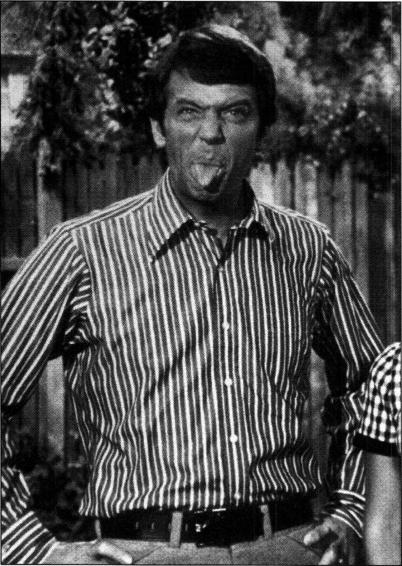
"... this is for you
Sherwood!"
(Courtesy Sherwood
Schwartz)
4. Farce
5. Slapstick
6. Satire &
7. Fantasy
They require not only a difference in terms of construction, but
also in presentation and, most explicitly, styles of acting. Their
dramatis personae are noninterchangeable. For example, Hamlet,
archtypical of the dramatic character, could not be written into
Midsummer Night's Dream and still retain his identity. Ophelia
could not play a scene with Titania; Richard II could not be found
in Twelfth Night. In other words, a character indigenous to one
style of the theatre cannot function in any of the other styles.
Obviously, the precept holds true for any period. Andy Hardy could
not suddenly appear in Citizen Kane, or even closer in style, Andy
Hardy could not appear in a Laurel and Hardy film. Andy Hardy is a
"comedic" character, Laurel and Hardy are of the purest slapstick. The boundaries are rigid, and within the confines of one theatrical piece the style must remain constant.
Why? It is a long since proven theorem in the theatre that an
audience will adjust its suspension of belief to the degree that
the opening of the presentation leads them. When a curtain rises
on two French maids in a farce set discussing the peccadilloes of
their master, the audience is now set for an evening of theatre in
a certain style, and are prepared to accept having excluded certain levels of reality. And that is the prime difference in the styles
of theatre, both for the actor and the writer-the degree of reality
inherent. Pure drama and comedy are closest to core realism,
slapstick and fantasy the farthest removed. It is also part of that
theorem that one cannot change styles midstream. How often do
we read damning critical reviews of, let's say, a drama in which a
character has "hammed" or in stricter terms become melodramatic. How often have we criticized the "mumble and scratch"
approach to Shakespearean melodrama, because ultra-realism is
out of place when another style is required. And yet, any of these
attacks could draw plaudits when played in the appropriate
genre.
Television falls under exactly the same principle. What the networks in their oversimplification call "sitcoms" actually are quite
diverse styles except where bastardized by careless writing or
performing. For instance:
"M*A*S*H" ... comedy
"The Paul Lynde Show" ... Farce
"Beverly Hillbillies" ... Slapstick
"Batman" ... Satire
"I Dream of Jeannie" ... Fantasy
And the same rules hold just as true. Imagine a scene in
"M*A*S*H" in which Arthur Hill appears playing his "Owen
Marshall" role, or Archie Bunker suddenly landing on "Gilligan's
Island," or Dom DeLuise and his mother in "Mannix." Of course,
any of these actors could play in any of these series in different
roles predicated on the appropriate style of acting. But the maxim
implicit in all this is: when the first-act curtain rises on a comedy,
the second-act curtain has to rise on the same thing, with the
actors playing in commensurate styles.
If it isn't already clear, not only does the audience accept a
certain level of belief, but so must the actor in order to function at
all. His consciousness opens like an iris to allow the proper
amount of reality into his acting subtext. And all the actors in the
same piece must deal with the same level, or the audience will not
know to whom to adjust and will most often empathize with the
character with the most credibility-total reality eliciting the most
complete empathic response. Example: We are in the operating
room in "M*A*S*H," with the usual pan shot across a myriad of
operating tables filled with surgical teams at work. The leads are
sweating away at their work, and at the same time engaged in
banter with the head nurse. Suddenly, the doors fly open and
Batman appears! Now the scene cannot go on. The "M*A*S*H"
characters, dealing with their own level of quasi-comic reality,
having subtext pertinent to the scene, cannot accept as real in
their own terms this other character. Oh yes, they could make fast
adjustments. He is a deranged member of some battle-fatigued
platoon and somehow came upon a Batman suit. But the Batman
character cannot then play his intended character true to his own
series. Even if it were possible to mix both styles, it would have to
be dealt with by the characters, not just abruptly accepted.
Meanwhile, the audience will stick with that level of reality to
which they have been introduced, and unless the added character
quickly adjusts, will reject him.
The most generic problem to date in "The Brady Bunch" has
been this almost constant scripted inner transposition of styles.
1. A pie-throwing sequence tacked unceremoniously onto the end
of a weak script.
2. The youngest daughter in a matter of a few unexplained hours
managing to look and dance like Shirley Temple.
3. The middle boy happening to run into a look-alike in the halls of
his school, with so exact a resemblance he fools his parents.
And the list goes on.
Once again, we are infused with the slapstick. The oldest boy's
hair turns bright orange in a twinkling of the writer's eye, having
been doused with a non-FDA-approved hair tonic. (Why any boy of
Bobby's age, or any age, would be investing in something as outmoded and unidentifiable as "hair tonic" remains to be explained.
As any kid on the show could tell the writer, the old hair-tonic routine is right out of "Our Gang." Let's face it, we're long since past
the "little dab'II do ya" era.)
Without belaboring the inequities of the script, which are varied and numerous, the major point to all this is: Once an actor has
geared himself to play a given style with its prescribed level of
belief, he cannot react to or accept within the same confines of
the piece, a different style.
When the kid's hair turns red, it is Batman in the operating
room.
I can't play it.
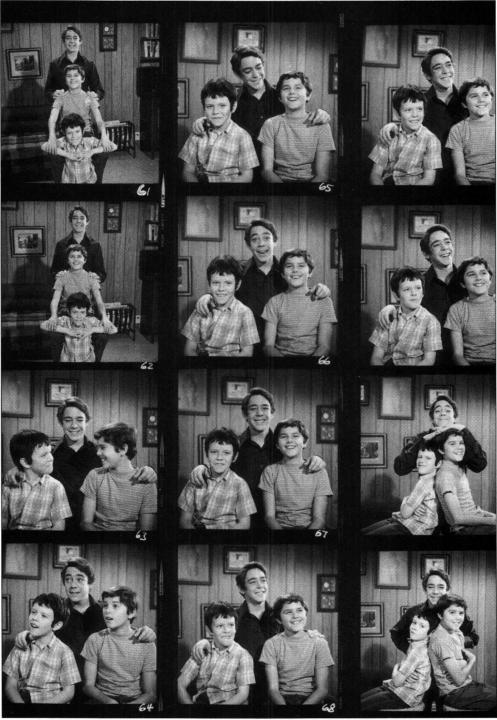
Posing for publicity shots. (Courtesy Sherwood Schwartz)
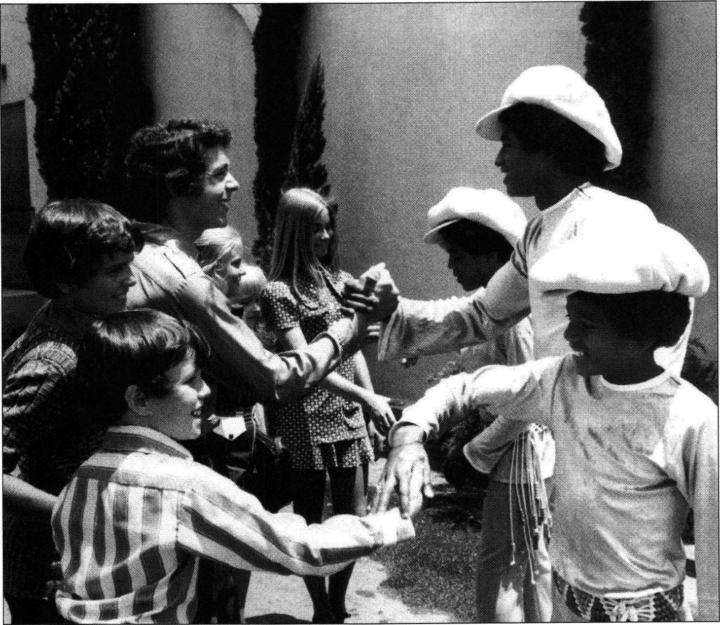
Brady 6 meets Jackson 5. Michael Jackson is in the foreground shaking hands with Michael
Lookinland. ((D 1991 Capital Cities/ABC, Inc.)
Bradys meet
Partridges.
((D Karen
Lipscomb)
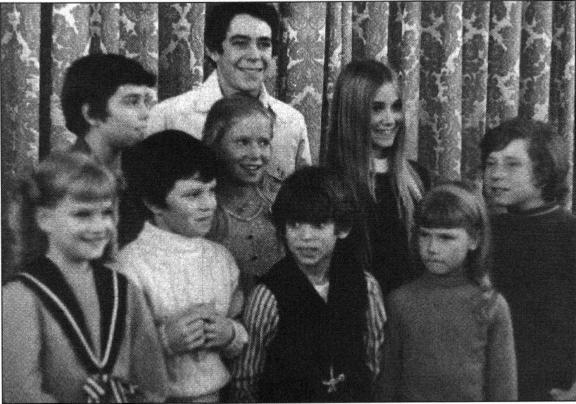
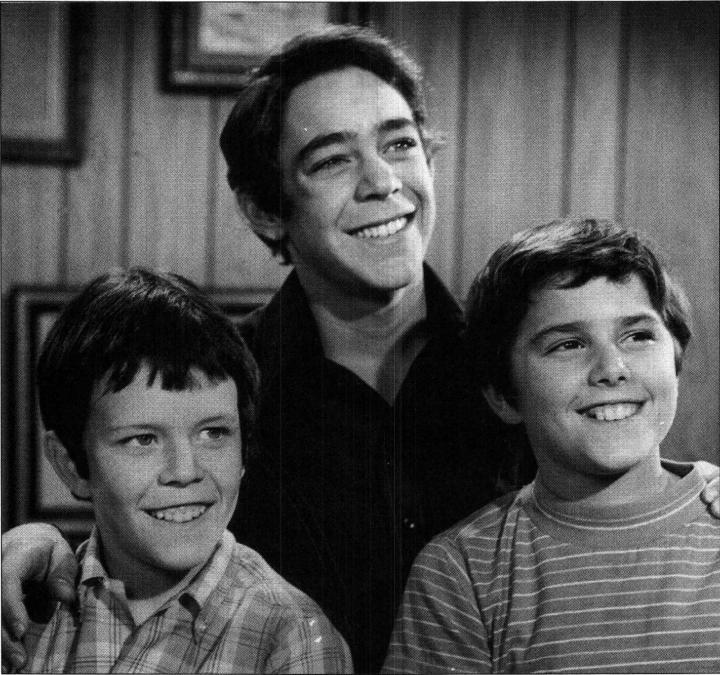
No cavities here. (Courtesy Sherwood Schwartz)
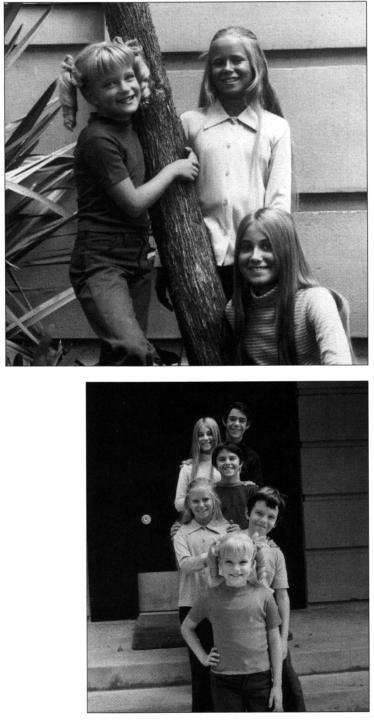
Posing for
publicity
shots.
(Courtesy
Sherwood
Schwartz)
